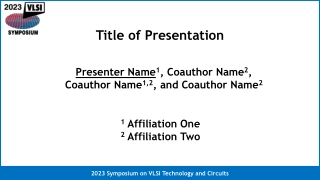Understanding Domain Name System (DNS) Fundamentals
The Domain Name System (DNS) is a crucial component of the Internet, facilitating the conversion of human-readable domain names into IP addresses. This session covers the basics of DNS, the need for names in computing, challenges of the old HOSTS.TXT system, the distributed nature of DNS, its hierarchical structure, and the rules governing domain names. Dive into the world of DNS to grasp its importance and functionalities in the digital realm.
Download Presentation

Please find below an Image/Link to download the presentation.
The content on the website is provided AS IS for your information and personal use only. It may not be sold, licensed, or shared on other websites without obtaining consent from the author. Download presentation by click this link. If you encounter any issues during the download, it is possible that the publisher has removed the file from their server.
E N D
Presentation Transcript
Domain Name System (DNS) Session-1: Fundamentals Joe Abley AfNOG Workshop, AIS 2017, Nairobi
Computers use IP addresses. Why do we need names? Names are easier for people to remember Computers may be moved between networks, in which case their IP addresses will change. Services might move between computers, in which case their IP addresses will change.
The old solution: HOSTS.TXT A centrally-maintained file, distributed to all hosts on the Internet SPARKY 128.4.13.9 UCB-MAILGATE 4.98.133.7 FTPHOST 200.10.194.33 ... etc This feature still exists: /etc/hosts (UNIX) c:\windows\hosts
hosts.txt does not scale Huge file (traffic and load) Name collisions (name uniqueness) Consistency Always out of date Single point of Administration Did not scale well
The Domain Name System was born DNS is a distributed database for holding name to IP address (and other) information Distributed: Shares the Administration Shares the Load Robustness and improved performance achieved through replication and caching Employs a client-server architecture A critical piece of the Internet's infrastructure
DNS is Hierarchical .(root) / (root) com bw org usr etc bin /etc/rc.d usr/local usr/sbin yahoo.com org.bw afnog.org nsrc.org usr/local/src bocra.org.bw ws.afnog.org DNS Database Unix Filesystem Forms a tree structure
DNS is Hierarchical (contd.) Globally unique names Administered in zones (parts of the tree) You can give away ("delegate") control of part of the tree underneath you Example: org on one set of nameservers afnog.org on a different set ws.afnog.org on a different set
Domain Names are (almost) unlimited Max 255 characters total length Max 63 characters in each label RFC 1034, RFC 1035 If a domain name is being used as a host name, you should abide by some restrictions RFC 952 (old!) a-z 0-9 and minus (-) only No underscores ( _ )
Using the DNS A Domain Name (like www.ws.afnog.org) is the KEY to look up information The result is zero or more RESOURCE RECORD SETS (RRSets) There are different RRTYPEs for different types of information You can ask for the specific type you want, or ask for "any" RRs associated with the domain name
Commonly seen Resource Record Types (RRTYPEs) A (address): map hostname to IPv4 address AAAA (quad A): map a hostname to IPv6 address PTR (pointer): map IP address to hostname MX (mail exchanger): where to deliver mail for a mail domain CNAME (canonical name): map alternative hostname to real hostname TXT (text): any descriptive text NS (name server), SOA (start of authority): used for delegation and management of the DNS itself
A Simple Example Query: Query type: Result: www.afnog.org. A www.afnog.org. 14400 IN A 196.216.2.4 In this case a single RR is found, but a set of multiple RRs may be returned. (IN is the "class" for INTERNET use of the DNS)
Possible results from a Query POSITIVE ( NOERROR ) the name exists, and has zero or more RRSets associated with it NEGATIVE ( NXDOMAIN ) the name does not exist SERVER FAILURE ( SERVFAIL ) server is having bad hair day FORMAT ERROR ( FORMERR ) the query you sent was broken in some way REFUSED ( REFUSED ) You are not allowed to query the server
How do you use an IP address as the key for a DNS query Convert the IP address to dotted-quad Reverse the four parts Add ".in-addr.arpa." to the end; special domain reserved for this purpose e.g. to find name for 193.194.185.25 Domain name: 25.185.194.193.in-addr.arpa. Query Type: PTR Result: ashanti.gh.com. Known as a "reverse DNS lookup" (because we are looking up the name for an IP address, rather than the IP address for a name)
DNS is a Client-Server application (Of course - it runs across a network) Requests and responses are most frequently carried in UDP packets, port 53 DNS can also use TCP transport, port 53 for large responses (not just zone transfers) because you want to exchange more than one query/response on a single session because a response you received told you to with TC=1 because UDP is being aggressively rate-limited or blocked (e.g. to mitigate a reflection attack)
There are three roles involved in DNS e.g. web browser Application Caching Resolver Authoritative Nameserver Stub Resolver
Three roles in DNS STUB RESOLVER Takes request from application, formats it into UDP packet, sends to recursive resolver RECURSIVE RESOLVER Returns the answer if already known Otherwise searches for an authoritative server which has the information Caches the result for future queries AUTHORITATIVE NAMESERVER Contains the actual information published in the DNS by the domain owner
Three roles in DNS The SAME protocol is used for stub<->resolver and resolver <->auth nameserver It is possible to configure a single name server as both a resolver and an authoritative server But it still performs only one role for each incoming query Common but NOT RECOMMENDED to configure in this way (we will see why later).
ROLE 1: THE STUB RESOLVER A piece of software which formats a DNS request into a DNS message, sends it to a resolver, and decodes the response when it arrives Usually a shared library (e.g. libresolv.so under Unix) because so many applications need it EVERY host needs a stub resolver - e.g. every Windows workstation has one
How does the stub resolver find a recursive nameserver? It has to be explicitly configured (statically, or via DHCP etc) Must be configured with the IP ADDRESS of a cache (why not its name?) Good idea to configure more than one recursive nameserver, in case the first one fails But failover between them might not be quick
How do you choose which recursive resolver(s) to configure? Must have PERMISSION to use it e.g. recursive resolver at your ISP, or your own, or a deliberately-public one Prefer a nearby recursive resolver Minimises round-trip time and packet loss Can reduce traffic on your external link, since often the cache can answer without contacting other servers Prefer a reliable recursive resolver Perhaps your own?
Stub resolvers can be configured with search domain(s) If "foo.bar" fails, then retry query as "foo.bar.mydomain.com" Can save typing but adds confusion May generate extra unnecessary traffic Usually best avoided
Example: Unix stub resolver configuration /etc/resolv.conf search sse.ws.afnog.org nameserver 196.200.219.200 nameserver 196.200.223.1 That's all you need to configure a resolver
Testing DNS Just put "www.yahoo.com" in a web browser? Why is this not a good test?
Testing DNS with "dig" "dig" is a program which just makes DNS queries and displays the results Better than "nslookup", "host" because it shows the raw information in full dig ws.afnog.org. -- defaults to query type "A" dig afnog.org. mx -- specified query type dig @196.200.223.1 afnog.org. mx -- send to particular cache (overrides /etc/resolv.conf)
The trailing dot # dig ws.afnog.org. Prevents any default domain being appended Get into the habit of using it always when testing DNS only on domain names, not IP addresses or e-mail addresses
[field@term /usr/home/field]$ dig @zoe.dns.gh. downloads.dns.gh. a ; <<>> DiG 9.3.1 <<>> @zoe.dns.gh. downloads.dns.gh. a ; (1 server found) ;; global options: printcmd ;; Got answer: ;; ->>HEADER<<- opcode: QUERY, status: NOERROR, id: 34963 ;; flags: qr aa rd ra; QUERY: 1, ANSWER: 2, AUTHORITY: 3, ADDITIONAL: 0 ;; QUESTION SECTION: ;downloads.dns.gh. IN A ;; ANSWER SECTION: downloads.dns.gh. 3600 IN CNAME zoe.dns.gh. zoe.dns.gh. 3600 IN A 147.28.0.23 ;; AUTHORITY SECTION: dns.gh. 3600 IN NS zoe.dns.gh. dns.gh. 3600 IN NS mantse.gh.com. dns.gh. 3600 IN NS snshq902.ghanatel.com.gh. ;; Query time: 275 msec ;; SERVER: 147.28.0.23#53(147.28.0.23) ;; WHEN: Sat May 24 00:17:53 2008 ;; MSG SIZE rcvd: 145
Understanding output from dig STATUS NOERROR: 0 or more RRs returned NXDOMAIN: non-existent domain SERVFAIL: cache could not locate answer REFUSED: query not available on cache server FLAGS AA: Authoritative answer (not from cache) You can ignore the others QR: Query/Response (1 = Response) RD: Recursion Desired RA: Recursion Available ANSWER: number of RRs in answer
Understanding output from dig Answer section (RRs requested) Each record has a Time To Live (TTL) Says how long the cache will keep it Authority section Which nameservers are authoritative for this domain Additional section More RRs (typically IP addresses for the authoritative nameservers) Total query time Check which server gave the response! If you make a typing error, the query may go to a default server























